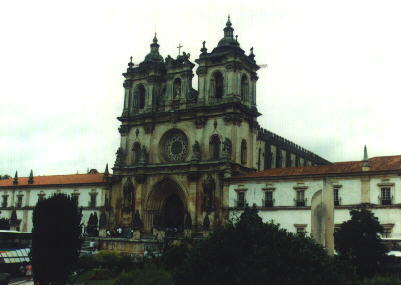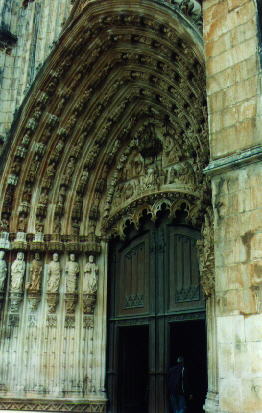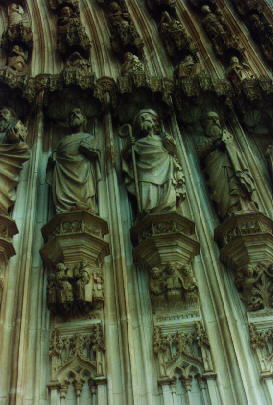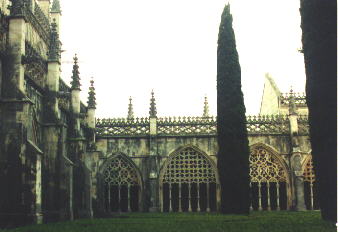

"Real Abadia de Santa Maria de Alcobaca at Alcobaca, Leiria, dates to the time of the first monarch, D. Afonso Henriques, and belonged to the French Cistercian Order of St Bernard de Clairvaux (who by the way, wrote the Rule for the original Poor Knights of Christ (Templar)...). The Alcobaca Abbey purportedly resembled the mother house at Clairvaux France.
It has been much "embellished" and now displays a melange of styles of which the baroque stands out overwhelmingly. I understand that there is quite a bit of archaeological digging going on currently which is rewriting former "beliefs" about its original layout..."
My sincere appreciation to an online friend "Pastoria" for supplying the above information. I had incorrectly identified the above photograph as that of the Abbey of Batalha...
Surname: Leiria - "Procedem de Joao de Leiria, natural de Leiria (Portugal), homem nobre, encarregado por Simao Goncalves da Camara, 3rd Donatario do Funchal(Madeira), de levar um presente ao Papa Leao X que teve foros historicos de embaixada principesca. Era casado com D.Isabel Anes Drumond, decendente dos Drumonds da qual teve geracao muito distinta que se ligou aos Freitas da Madalena, Carvalhos Ferreiras e a outros. Duma filha daqueles, Leonor Escorcio, casada com Joao Rodrigues, Escudeiro Fidalgo, de Santa Cruz, provem as familias de apelido Escorcio Rodrigues."
Source: Genealogia da Ilha da Madeira
Joao de Leiria and Isabel Anes Drumond were my maternal 14th great-grandparents (Patricia Julia da Silva Se Corbera)
Dom Afonso Henriques founded the Alcobaca Abbey as an offering of thanks for the capture of Santarem from the Moors. Construction began in 1178, the year before Pope Alexander III recognized the new Christian nation of Portugal.
Before the "Black Death" reduced the number to eight, there was said to have been 999 monks at the abbey. From the mid-13th century, the monks washed their hands of any farm work, to devote themselves to teaching. They founded the country's first public school in 1269, and provided books and money to help Dom Dinis to establish the University of Lisbon, which was later moved to Coimbra.
Junot's soldiers pillaged the abbey in 1810, and the monks were expelled in 1834, when the religious orders were extinguished.
The abbey contains the tombs of those impossible lovers, Dom Pedro and Ines de Castro. After the death of his wife, Prince Dom Pedro fell in love with her Spanish lady-in-waiting, Dona Ines de Castro. Fearful of her brothers' influence, leading nobles poisoned King Dom Afonso IV's mind against her. He sanctioned her murder, unaware that the couple had married in secret at Braganca, to legitimize their children. "Inez's heron-neck was severed at Coimbra."
When Dom Pedro succeeded to the throne two years later, in 1357, two of the three murderers were brought to him at Santarem, tied to an ox-yoke. He is reported to have ripped out their hearts and eaten them, before exhuming Ines' decomposing body and compelling the nobility to do homage to her, prior to her entombment in the abbey.
The tomb of Dom Pedro and Ines de Castro stand in the transepts, foot to foot, as requested, so that on Judgment Day they will open their eyes and see one another.
A chapel off the south transept contains the tombs of Kings Dom Afonso II and Dom Afonso III, as well as the mutilated 17th century terra-cotta tableau of the death of St. Bernard incorporating some 30 figures and their complex hairdos.

When D. Fernando I died in 1383, his wife Leonor Teles assumed
the position of regent, assisted by her lover Count Andeiro.
The king had died without a son; his daughter Beatriz
was married to the King of Castile, Juan I, who added the arms
of Portugal to his standard,
and ordered all Portuguese townships to proclaim Beatriz as queen.
Those who feared absorption by Castile
focused their hopes on one of D. Fernando's illegitimate
half-brothers, D. Joao of Aviz. Who was highly admired by the
the common people of Lisbon.
Having consulted a visionary Castilian hermit, D. Joao sought
an audience with the queen,
who sat doing needlework and wondered why D. Joao was armed
and "
not wearing gloves as the English do." She soon found out...
D. Joao murdered her lover and forced her to flee for her life.
He was proclaimed king at the palace window, but did not receive
official backing until the Cortes
met at Coimbra in 1385. Juan I of Castile set his sights on
besieging Lisbon, which was held by the Portuguese
forces together with the castles around the capital, and much of
the Alentejo. As the Castilian forces advanced, they cut off the
head, or hands, or tongues of those Portuguese whom they
captured.
On Tuesday, 14 August 1385, Nun' Alvares Pereira commanded the
Portuguese army to take up a position at Sao Jorge on the Lisbon
road. For this he used English terminology--
the van, the rear, the right and left wings--which had been
learned from the English armies in the Hundred Years War. On
their left flank, the 6500 Portuguese troops were supported by
about 500 English crossbowmen, sent by Richard II. Together they
dug shallow trenches, which were covered with brushwood.
In the evening 30,000 Castilian troops came within range,
traveling south. Juan I, being ill, rode a donkey, and forbade
engagement with the Portuguese army, but his hidalgos
were impetuous, and broke rank.
The battle of Aljubarotta was over quickly -- the Castilian royal
standard fell within an hour -- but its effects were tremendous...
it secured the independence of Portugal from Spanish domination
until the dynasty of Aviz was brought to an end 200 years later. Joao of Aviz became D. Joao I, the undisputed ruler of a united kingdom.
Many Portuguese nobles were killed, fighting for the Castilian
king against the upstart "bastard Joao." The latter's success
heralded the reorganization of the nobility, elevating members of
the bourgeoisie, artisans and the petty aristocracy. But it also
had a more tangible legacy...before the battle Joao had vowed
to build an abbey should he be victorious. Work on the Dominican
Battle Abbey started three years later, in 1388, near the site of his victory.

The western portal is very finely carved, with six columns either side of the doorway, on each of which stand modern copies of the 12 Apostles. Above them rise a series of arched niches with biblical kings and queens, the prophets and the angels. On the tympanum, the Creator is surrounded by the four Evangelists.

The Capela do Fundador was completed in 1434, after the death of Joao I. It centers on the tomb of Joao I and Philippa of Lancaster, whose effigies lie hand in hand beneath an exquisite octagonal lantern. He wears the insignia of the Order of the Garter, which was founded by Philippa's Grandfather, Edward III. The rear wall is lined with the tombs of their four younger sons. D. Fernando's is farthest to the left; he was left as a hostage for the return of Ceuta to the Moors, following the capture of the Portuguese army by Sala-ben-Sala in 1437. D. Fernando was put to work in the vizier's garden and stables at Fez, before being confined to a dungeon, where he died of dysentery after five years of captivity. His body was hung by the feet from the walls of Fez, from this awkward position his Portuguese companions cut out his heart and embalmed it. This was brought to Batalha, and the scant remains of his other parts followed later in 1471. Henry the Navigator's tomb is second from the right.

The nave opens onto the Claustro Real, built by Afonso Domingues, who was master of works from 1388 to 1402. D. Manuel found it unsatisfying, and ordered Boitac to embellish the arches with marvelous thorny tracery, entwining crosses of the Order of Christ, employing pearly columns and scaly artichokes (which prevented scurvy and were thus revered by the navigators). An arch opens onto the Chapter House, where the forceful unsupported vault proves a suitable setting for the Tomb of the Unknown Soldiers, one from Africa, and one from the Flanders front. The Refectory is now a military museum and gift shop. At right angles to it stands the sober and elegant Gothic Claustro de D. Afonso V.
D. Duarte, the pious eldest son of D. Joao I and Philippa of Lancaster, attached a self-contained octagonal mausoleum to the east end of the abbey, the roofless Capelas Imperfeitas (Unfinished Chapels). Architect Ouguete began work on the seven radial chapels abt 1435, but his design was profoundly altered by the imaginative genius of Mateus Fernandes, D. Manuel's master of works, who intended to build an upper octagon, but was able only to begin construction on the forlorn stumps of its buttresses.
The true legacy of Mateus Fernandes is the stunning western portal, created 1509. D. Duarte died in 1438 and was entombed in a chapel opposite the entrance.
Four km south of Batalha, and 10 km north-east of the village of
Aljubarrota, the Chapel of S. Jorge marks the battleground of
Aljubarrota. The Spaniards were defeated in one hour, which was
long enough for Nun' Alvares Pereira, the commander of the
Portuguese troops, to get up a sweat. A jug of water stands in
the porch of the chapel, to quench the thirst of his ghost. Nearby stands an iron statue of a baker's wife, who
served her country by hitting Castilians with a baker's shovel.
History noted that when the battle was over the King of Castile
scampered off and "tore his hair and plucked off his beard by
handfuls, and raved and ranted like a maniac --
the details of this frantic pluck-age are to be found in a letter
from the Constable Nun' Alvarez Pereira to the Abbot of Alcobaca."

